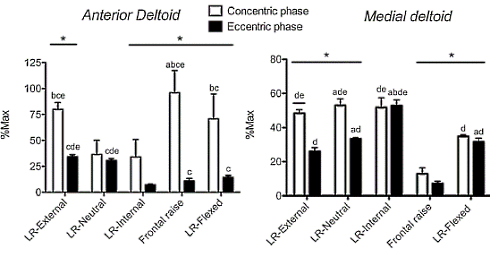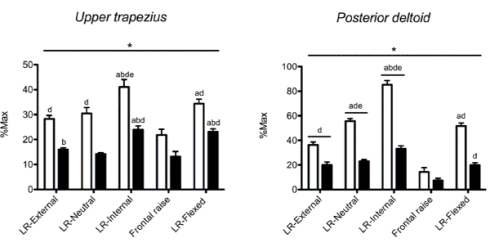This is perhaps the most effective version of the lateral raise
Performing the lateral raise with the thumbs down isn't just an exercise that engages the outside of the shoulder muscles. This exercise also stimulates the back of the shoulder muscles and the trapezius, Italian sports scientists at the Universita degli Studi di Milano report in the International Journal of Environmental Research and Public Health.
[FONT="]
[/FONT]

[FONT="]
[/FONT]
Study
The researchers got ten competitive bodybuilders to perform different variations of the lateral raise and the frontal raise. The researchers attached electrodes to the subjects' skin to measure the activity of the underlying muscles. This allowed them to see which variant stimulated which muscle groups best.Results
The traditional lateral raise [LR Neutral] is a great exercise for the side of the shoulders [medial deltoid], the traditional front raise is a great exercise for the front of the shoulders [anterior deltoid]. No surprises there.
The lateral raise with the elbows bent is not the best exercise for developing the outside of the shoulder muscles. Not surprising either.
[FONT="]
[/FONT]


[FONT="]
[/FONT]
What is surprising is the effectiveness of the lateral raise with internal rotation - at least, according to the Italian research. For the outside of the shoulder muscles, this exercise is a bit better than the traditional lateral raise. In addition, this variant also stimulates the back of the shoulders [posterior deltoid] and the trapezius.
[FONT="]
[/FONT]

[FONT="]
[/FONT]
Caveat
The lateral raise with internal rotation is a relatively risky exercise, known to sometimes cause injuries. If you are unfamiliar with it, it may be wise to inform yourself about the correct implementation before you start experimenting with it.
Source:
Int J Environ Res Public Health. 2020 Aug 19;17(17):6015.
Performing the lateral raise with the thumbs down isn't just an exercise that engages the outside of the shoulder muscles. This exercise also stimulates the back of the shoulder muscles and the trapezius, Italian sports scientists at the Universita degli Studi di Milano report in the International Journal of Environmental Research and Public Health.
[FONT="]
[/FONT]

[FONT="]
[/FONT]
Study
The traditional lateral raise [LR Neutral] is a great exercise for the side of the shoulders [medial deltoid], the traditional front raise is a great exercise for the front of the shoulders [anterior deltoid]. No surprises there.
The lateral raise with the elbows bent is not the best exercise for developing the outside of the shoulder muscles. Not surprising either.
[FONT="]
[/FONT]


[FONT="]
[/FONT]
What is surprising is the effectiveness of the lateral raise with internal rotation - at least, according to the Italian research. For the outside of the shoulder muscles, this exercise is a bit better than the traditional lateral raise. In addition, this variant also stimulates the back of the shoulders [posterior deltoid] and the trapezius.
[FONT="]
[/FONT]

[FONT="]
[/FONT]
Caveat
The lateral raise with internal rotation is a relatively risky exercise, known to sometimes cause injuries. If you are unfamiliar with it, it may be wise to inform yourself about the correct implementation before you start experimenting with it.
Source:
Int J Environ Res Public Health. 2020 Aug 19;17(17):6015.


